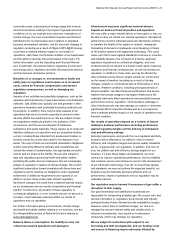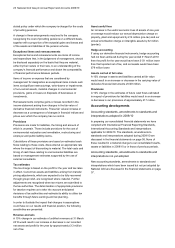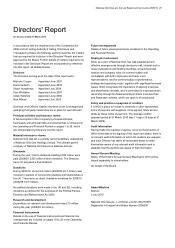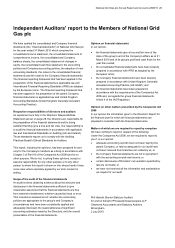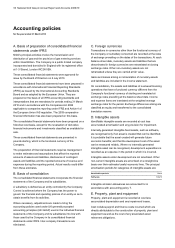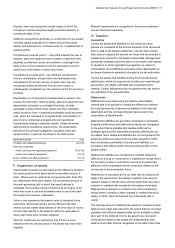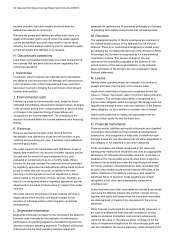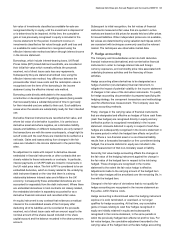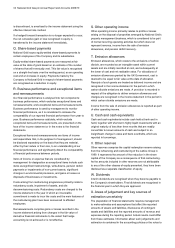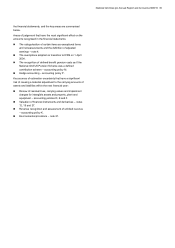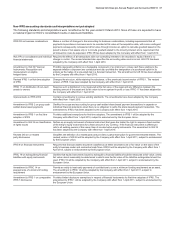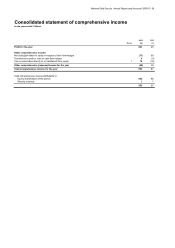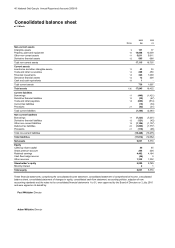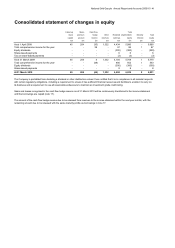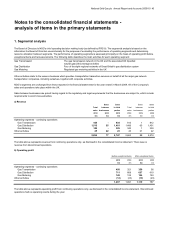National Grid 2010 Annual Report Download - page 35
Download and view the complete annual report
Please find page 35 of the 2010 National Grid annual report below. You can navigate through the pages in the report by either clicking on the pages listed below, or by using the keyword search tool below to find specific information within the annual report.National Grid Gas plc Annual Report and Accounts 2009/10 33
fair value of investments classified as available-for-sale are
recognised directly in equity, until the investment is disposed of
or is determined to be impaired. At this time, the cumulative
gain or loss previously recognised in equity is included in the
income statement for the period. Investment income on
investments classified as fair value through profit and loss and
on available-for-sale investments is recognised using the
effective interest rate method and taken through interest income
in the income statement.
Borrowings, which include interest-bearing loans, UK Retail
Prices Index (RPI) linked debt and overdrafts, are recorded at
their initial fair value which normally reflects the proceeds
received, net of direct issue costs less any repayments.
Subsequently they are stated at amortised cost, using the
effective interest rate method. Any difference between the
proceeds after direct issue costs and the redemption value is
recognised over the term of the borrowing in the income
statement using the effective interest rate method.
Borrowing costs directly attributable to the acquisition,
construction or development of qualifying assets (being assets
that necessarily take a substantial period of time to get ready
for their intended use) are added to their cost. Such additions
cease when the assets are substantially ready for their intended
use.
Derivative financial instruments are recorded at fair value, and
where fair value of a derivative is positive, it is carried as a
derivative asset and where negative, as a derivative liability.
Assets and liabilities on different transactions are only netted if
the transactions are with the same counterparty, a legal right to
set-off exists and the cash flows are intended to be settled on a
net basis. Gains and losses arising from changes in the fair
value are included in the income statement in the period they
arise.
No adjustment is made with respect to derivative clauses
embedded in financial instruments or other contracts that are
closely related to those instruments or contracts. In particular,
interest payments on UK RPI debt are linked to movements in
the UK retail price index. The link to RPI is considered to be an
embedded derivative, which is closely related to the underlying
debt instrument based on the view that there is a strong
relationship between interest rates and inflation in the UK
economy. Consequently these embedded derivatives are not
accounted for separately from the debt instrument. Where there
are embedded derivatives in host contracts not closely related,
the embedded derivative is separately accounted for as a
derivative financial instrument and recorded at fair value.
An equity instrument is any contract that evidences a residual
interest in the consolidated assets of the Company after
deducting all of its liabilities and is recorded at the proceeds
received, net of direct issue costs with an amount equal to the
nominal amount of the shares issued included in the share
capital account and the balance recorded in the share premium
account.
Subsequent to initial recognition, the fair values of financial
instruments measured at fair value that are quoted in active
markets are based on bid prices for assets held and offer prices
for issued liabilities. When independent prices are not available,
fair values are determined by using valuation techniques which
are consistent with techniques commonly used by the relevant
market. The techniques use observable market data.
P. Hedge accounting
The Company and its subsidiaries enter into both derivative
financial instruments (derivatives) and non-derivative financial
instruments in order to manage interest rate and foreign
currency exposures, and commodity price risks associated with
underlying business activities and the financing of those
activities.
Hedge accounting allows derivatives to be designated as a
hedge of another (non-derivative) financial instrument, to
mitigate the impact of potential volatility in the income statement
of changes in fair value of the derivative instruments. To qualify
for hedge accounting documentation is prepared specifying the
hedging strategy, the component transactions and methodology
used for effectiveness measurement. The Company uses two
hedge accounting methods.
Firstly, changes in the carrying value of financial instruments
that are designated and effective as hedges of future cash flows
(cash flow hedges) are recognised directly in equity and any
ineffective portion is recognised immediately in the income
statement. Amounts deferred in equity in respect of cash flow
hedges are subsequently recognised in the income statement in
the same period in which the hedged item affects net profit or
loss. Where a non-financial asset or a non-financial liability
results from a forecasted transaction or firm commitment being
hedged, the amounts deferred in equity are included in the
initial measurement of that non-monetary asset or liability.
Secondly, fair value hedge accounting offsets the changes in
the fair value of the hedging instrument against the change in
the fair value of the hedged item in respect to the risk being
hedged. These changes are recognised in the income
statement to the extent the fair value hedge is effective.
Adjustments made to the carrying amount of the hedged item
for fair value hedges will be amortised over the remaining life, in
line with the hedged item.
Changes in the fair value of derivatives that do not qualify for
hedge accounting are recognised in the income statement as
they arise, within finance costs.
Hedge accounting is discontinued when the hedging instrument
expires or is sold, terminated, or exercised, or no longer
qualifies for hedge accounting. At that time, any cumulative
gains or losses relating to cash flow hedges recognised in
equity are initially retained in equity and subsequently
recognised in the income statement, in the same periods in
which the previously hedged item affects net profit or loss. For
fair value hedges, the cumulative adjustment recorded to the
carrying value of the hedged item at the date hedge accounting


